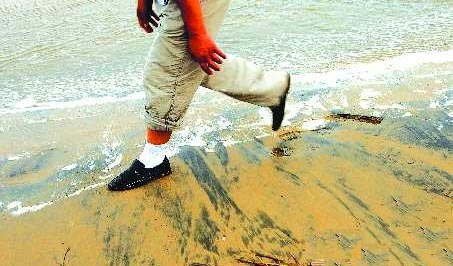Oil still leaking at 2 platforms on NE China sea
 0 Comment(s)
0 Comment(s) Print
Print E-mail
Xinhua, July 30, 2011
E-mail
Xinhua, July 30, 2011
Oil continues to leak at ConocoPhillips's two platforms in northeast Bohai Bay more than two weeks after Chinese authorities ordered a shutdown of their output, said China's oceanic watchdog on Friday.
|
|
|
Oil pollutants, possibly from the oil leak at the the Penglai oilfield, are seen over some beaches of Leting City of Hebei Province, July 25, 2011. [Photo: QLWB.com] |
The surveillance has determined that the oilfield's platform C is leaking at a speed of about 2.52 liters per day and found oil belts near platform B despite the company's cleaning efforts, said Lin Fangzhong, an official with SOA North China Sea Branch, on Friday.
The density of oil pollutants per liter of sea water sampled in the area reached a maximum of 118 micrograms, far exceeding the limit of 50 micrograms per liter set for the country's the second-class sea water quality, which is applicable to aquiculture areas and direct sea water contact for the human body, he said.
Before the oil leak, the sea water quality in the area had reached the country's level one standard.
The oilfield is jointly operated by ConocoPhillips China (COPC), a subsidiary of US energy giant ConocoPhillips, and China National Offshore Oil Corporation (CNOOC), the country's largest offshore oil producer.
The SOA North China Sea branch has ordered COPC to contain the oil spills, clean up polluted areas and conduct a thorough investigation to eliminate further risks of spills and leaks before August 31.
COPC first reported the two oil spills to authorities in early and mid-June, when an area of 840 square kilometers was polluted.
Pollutants from the oil spill have been found spreading to beaches in northern Hebei Province and northeastern Liaoning Province, which have been blamed for losses in local tourism revenue and aquatic farming industry.
Another oil spill incident reported on July 12 occurred at the Suizhong 36-1 oilfield's central platform, which is also operated by CNOOC. It marked the third spill in two months in Bohai Bay.







Go to Forum >>0 Comment(s)